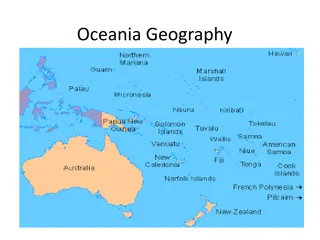
New Zealand's Primary Production Sectors and Economic Impact
Explore New Zealand's primary production sectors including agriculture, dairy manufacturing, horticulture, forestry, seafood, equine, and sports turf. These sectors play a pivotal role in the country's economy, contributing significantly to exports. Learn about the agricultural contributions of dairying, sheep meat, beef, wool, deer, and arable crops, highlighting New Zealand's position as a leading exporter in various industries.
Download Presentation

Please find below an Image/Link to download the presentation.
The content on the website is provided AS IS for your information and personal use only. It may not be sold, licensed, or shared on other websites without obtaining consent from the author. If you encounter any issues during the download, it is possible that the publisher has removed the file from their server.
You are allowed to download the files provided on this website for personal or commercial use, subject to the condition that they are used lawfully. All files are the property of their respective owners.
The content on the website is provided AS IS for your information and personal use only. It may not be sold, licensed, or shared on other websites without obtaining consent from the author.
E N D
Presentation Transcript
New Zealands New Zealand s Primary Primary Production Production Sectors. Sectors.
7 primary production sectors Agriculture, Dairy manufacturing, Horticulture Forestry, Seafood, Equine, Sports turf.
Primary Sector Economic Contribution. New Zealand s primary industries have a pivotal role in New Zealand economy and contribute to 81.9 % of exports
Agricultural Contribution. 1. Dairying. This is New Zealand s largest export earner, with $24.2. billion in 2024. In the 2022/23 season, there were 4.67 million cows, a 6.7% decrease from peak cow numbers of 5.01 million in 2014/15. Cow numbers are predicted to continue to decline. Dairy companies processed 20.7 billion litres of milk in 2022/2023 season. 95% or milk produced in New Zealand is exported to more than 130 countries. 2. Sheep Meat Sheep meat (lamb and mutton) was worth $3.83 billion in exports to New Zealand s economy in 2023. On an annual basis, New Zealand produces about 280,000 tonnes of lamb and 91,000 tonnes of mutton. New Zealanders consume about 4 kilograms of lamb (and .04 kilograms of mutton) per person a year. Total sheep numbers in 2023 was 24.4 million. Number are decline and predicated to decline further. 3. Beef The beef industry is the third largest export earner for agricultural products, with $4,597 million exported in 2023. The dairy industry is making a contribution to beef production. Culled dairy cows and bulls originating from dairy herds now contribute approximately 60% of all annual beef exports. 4. Wool $4513million worth of wool and wool products was exported overseas in 2023. New Zealand is the world s third largest exporter of wool and produces 9.3% of world production. 5. Deer New Zealand is the major world market supplier of venison earning 175million and one of the main suppliers of deer velvet worth $102 million to the New Zealand economy in 2022/23. 6. Arable The main arable crops grown in New Zealand are vegetable seeds, barley, wheat, maize grain, and oats. They are mainly growing in Canterbury and Southland. Exports are valued at $310 million.
Agricultural main products Dairying (milk only), Lamb, Beef, Wool, Deer, Arable grains and cereals.
Dairy manufacturing from raw milk, processed milk, & dairy substitutes. Products produced are; Milk powders, whole-milk, skim-milk & buttermilk powder; Cream products, butter, milk fat and ghee; Cheese, mainly cheddar, & specialist cheeses; Protein products such as casein & caseinates; Alcohols.
Dairy manufacturing contribution
Horticulture main products Fruit wine grapes, kiwifruit, apples & pears; Vegetables onions, squash, potatoes. Flowers
In 20234/34, the horticulture industry is New Zealand third largest export earner. The export revenue was $7.1 billion. Horticulture exports make up about 11% of total New Zealand merchandised exports. About 40,000 people are employed in the horticulture industry. Horticultural Contribution. Kiwifruit exports are now earning more than $2.5 billion. New Zealand kiwifruit are enjoyed by consumers in more than 50 countries, with two thirds of kiwifruit exports (by value) supplied to Asian countries. New Zealand's wine exports have also reached a new high earning more than $1.4 billion. New Zealand wine was exported to more than 100 countries, with three quarters of New Zealand's wine production dedicated to Sauvignon blanc. Other crops are also in demand by export markets. New Zealand apple exports have more than doubled in value since 2012 and now earn more than $892 million. New Zealand-bred varieties such as Jazz, Envy, Rockit and Pacific branded apples account for more than one quarter of exports. Onions are New Zealand s largest vegetable export crop. Export earnings were $140 million in 2022, with the majority of exports supplied to the UK and Europe. Potato exports remain steady, at close to $130 million, primarily as processed product for the Australian market. The New Zealand s avocado export earning was $37 million in 2023/24
Seafood & aquaculture Seafood & aquaculture main products are; Harvesting fish from deep- sea or inshore fishing, e.g., rock lobster, hoki, squid, & orange roughy; Aquaculture growing & harvesting fish & shellfish in marine farms, e.g., greenshell mussel, oysters king salmon & yellow tailed kingfish Processing fish & shellfish (at sea or on shore).
Seafood is New Zealand's fifth largest export by value and represents 3.2 percent of total exports. This includes fishing and seafood harvesting for deep water, inshore, highly migratory species and shellfish. Wild capture has a revenue of over 1.5 billion Aquaculture has a revenue of over $500 million. Total export revenue is over $2billion Seafood & aquaculture contribution
Forestry main products Forestry - planning, establishment, silviculture, and harvesting of trees); Sawmilling & remanufacturing; Wood panels; Pulp, paper and tissue; and Furniture. Forestry export revenue was $5.9 billion in 2023/24
Forestry Contribution. Forestry contributes: an annual gross income of around $6.6 billion 1.6% of New Zealand's GDP (Gross Domestic Product) to the employment of 35,000- 40,000 people in wood production, processing, and the commercial sector.
Equine The horse industry covers areas such as: Semen exporting Breeding and selling of racehorses TAB betting New Zealand's Thoroughbred, Standardbred and sport-horse industries collectively generate more than $NZ2 billion in gross domestic product (GDP) each year. That represents about 2% of the country's total GDP. The racing sector alone contributed an estimated $1.4 billion annually.
Sports Turf This area includes: City councils- parks/gardens , public sports fields Companies that are contracted by the council to look after sports fields Schools (ground staff) Racecourses, bowling greens and golf courses
National importance Economic Employment Export Revenue 2024 Dairy $24.2 billion Sheep & Beef $ 11.4 billion Horticulture $7.1billion Forestry $5.9 billion Viticulture $ 2.1 billion Arable $310million
Regional Importance Supports rural and urban communities Income Employment Infrastructure
Export markets What are New Zealand s 5 biggest exporting sectors? What are New Zealand s 3 biggest export markets?





















